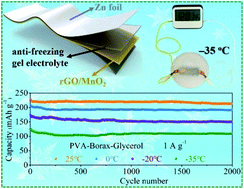当前位置:
X-MOL 学术
›
J. Mater. Chem. A
›
论文详情
Our official English website, www.x-mol.net, welcomes your
feedback! (Note: you will need to create a separate account there.)
Anti-freezing flexible aqueous Zn–MnO2 batteries working at −35 °C enabled by a borax-crosslinked polyvinyl alcohol/glycerol gel electrolyte
Journal of Materials Chemistry A ( IF 10.7 ) Pub Date : 2020/03/11 , DOI: 10.1039/d0ta01553a Minfeng Chen 1, 2, 3, 4 , Weijun Zhou 1, 2, 3, 4 , Anran Wang 1, 2, 3, 4 , Aixiang Huang 1, 2, 3, 4 , Jizhang Chen 1, 2, 3, 4 , Junling Xu 4, 5, 6, 7 , Ching-Ping Wong 4, 5, 6, 7, 8
Journal of Materials Chemistry A ( IF 10.7 ) Pub Date : 2020/03/11 , DOI: 10.1039/d0ta01553a Minfeng Chen 1, 2, 3, 4 , Weijun Zhou 1, 2, 3, 4 , Anran Wang 1, 2, 3, 4 , Aixiang Huang 1, 2, 3, 4 , Jizhang Chen 1, 2, 3, 4 , Junling Xu 4, 5, 6, 7 , Ching-Ping Wong 4, 5, 6, 7, 8
Affiliation

|
Flexible aqueous zinc-ion batteries (AZIBs) are promising to satisfy the emerging wearable electronics. However, conventional hydrogel electrolytes are unable to work at subzero temperatures because they inevitably freeze. In this work, a borax-crosslinked polyvinyl alcohol (PVA)/glycerol gel electrolyte is developed, in which glycerol can strongly interact with PVA chains, thus effectively prohibiting the formation of ice crystals within the whole gel network. Thanks to this, the freezing point of this gel electrolyte is below −60 °C, which allows it to work in extremely cold environments. Even at −35 °C, it still exhibits a high ionic conductivity of 10.1 mS cm−1 and great mechanical properties. On the basis of this anti-freezing gel electrolyte, a flexible quasi-solid-state aqueous Zn–MnO2 battery is assembled and realizes an impressive energy density of 46.8 mW h cm−3 (1330 μW h cm−2) at a power density of 96 mW cm−3 (2.7 mW cm−2) at 25 °C, outperforming nearly all the reported AZIBs. More importantly, when the temperature is reduced to −35 °C, a rather high energy density (25.8 mW h cm−3, 732 μW h cm−2) can still be achieved, and 53.3% of that value can be retained when the power density is increased to about 10-fold. This battery also shows excellent cycling durability (around 90% capacity retention over 2000 cycles) and great tolerance to various extreme conditions even when the temperature is down to −35 °C. These findings provide valuable insights into designing aqueous batteries/supercapacitors that can work in cold climates and high-altitude areas.
中文翻译:

硼砂交联的聚乙烯醇/甘油凝胶电解质可在−35°C的温度下工作的防冻柔性Zn-MnO2水性电池
灵活的水性锌离子电池(AZIB)有望满足新兴的可穿戴电子产品的需求。但是,传统的水凝胶电解质不可避免地会冻结,因此无法在低于零的温度下工作。在这项工作中,开发了硼砂交联的聚乙烯醇(PVA)/甘油凝胶电解质,其中甘油可以与PVA链强烈相互作用,从而有效地阻止了整个凝胶网络中冰晶的形成。因此,该凝胶电解质的凝固点低于-60°C,使其可以在极端寒冷的环境中工作。即使在-35°C,它仍显示出10.1 mS cm -1的高离子电导率和出色的机械性能。基于这种防冻凝胶电解质,一种柔性的准固态Zn-MnO 2水溶液组装电池并在25°C下以96 mW cm -3(2.7 mW cm -2)的功率密度实现46.8 mW h cm -3(1330μWh cm -2)的惊人能量密度,几乎胜过所有报告的AZIB。更重要的是,当温度降低至-35℃,具有相当高的能量密度(25.8毫瓦高厘米-3,732μW高厘米-2仍然可以实现),并且当功率密度增加到约10倍时可以保留该值的53.3%。该电池还具有出色的循环耐久性(在2000次循环中约有90%的容量保持能力),即使在温度降至-35°C时也能耐受各种极端条件。这些发现为设计可在寒冷气候和高海拔地区工作的水性电池/超级电容器提供了宝贵的见识。
更新日期:2020-04-08
中文翻译:

硼砂交联的聚乙烯醇/甘油凝胶电解质可在−35°C的温度下工作的防冻柔性Zn-MnO2水性电池
灵活的水性锌离子电池(AZIB)有望满足新兴的可穿戴电子产品的需求。但是,传统的水凝胶电解质不可避免地会冻结,因此无法在低于零的温度下工作。在这项工作中,开发了硼砂交联的聚乙烯醇(PVA)/甘油凝胶电解质,其中甘油可以与PVA链强烈相互作用,从而有效地阻止了整个凝胶网络中冰晶的形成。因此,该凝胶电解质的凝固点低于-60°C,使其可以在极端寒冷的环境中工作。即使在-35°C,它仍显示出10.1 mS cm -1的高离子电导率和出色的机械性能。基于这种防冻凝胶电解质,一种柔性的准固态Zn-MnO 2水溶液组装电池并在25°C下以96 mW cm -3(2.7 mW cm -2)的功率密度实现46.8 mW h cm -3(1330μWh cm -2)的惊人能量密度,几乎胜过所有报告的AZIB。更重要的是,当温度降低至-35℃,具有相当高的能量密度(25.8毫瓦高厘米-3,732μW高厘米-2仍然可以实现),并且当功率密度增加到约10倍时可以保留该值的53.3%。该电池还具有出色的循环耐久性(在2000次循环中约有90%的容量保持能力),即使在温度降至-35°C时也能耐受各种极端条件。这些发现为设计可在寒冷气候和高海拔地区工作的水性电池/超级电容器提供了宝贵的见识。











































 京公网安备 11010802027423号
京公网安备 11010802027423号